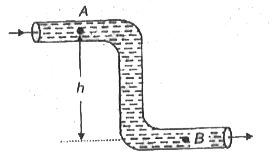A trough contains the two immiscible liquids 'A' and 'B' having densities . A cylindrical body having uniform area of cross section is immersed completely and vertically in the liquids such that of its length is in liquid 'B' and the remaining is in liquid 'A'. Find the density of the body.
Take the volume of cylindrical body as V.
Is the cylindrical body completely immersed in both immiscible liquids 'A' and 'B' ?
Find the volume of the cylinder immersed in liquid 'A' and also in liquid 'B' by using formula,
V=a.h (1)
Is this equal to the volume of the displaced liquids of 'A' (or) 'B' ?
Now, weight of floating body = weight of the displaced liquids = total upthrust acting on the body.
Here, weight of floating body = mg
= (2)
(3) Find the density of the body from equation (3)
Topper's Solved these Questions
- HYDROSTATICEBOOK - PEARSON IIT JEE FOUNDATIONCHAPTER - HYDROSTATICEEXERCISE - LEVEL 2 UNDERSTANDING BASED QUESTION
6 Videos
- HYDROSTATICEBOOK - PEARSON IIT JEE FOUNDATIONCHAPTER - HYDROSTATICEEXERCISE - LEVEL 3
5 Videos
- HYDROSTATICEBOOK - PEARSON IIT JEE FOUNDATIONCHAPTER - HYDROSTATICEEXERCISE - LEVEL 1 MULTIPLE CHOICE QUESTIONS
29 Videos
- HEATBOOK - PEARSON IIT JEE FOUNDATIONCHAPTER - HEATEXERCISE - All Questions
115 Videos
- LIGHTBOOK - PEARSON IIT JEE FOUNDATIONCHAPTER - LIGHTEXERCISE - Level 3
10 Videos
Similar Questions
A body is immersed in a liquid of relative density 2.6. It is found that the weight of the body in the liquid is two-thirds of its weight in air. Calculate the density of the body ?
View SolutionA body is immersed in a liquid of relative density 2.6. It is found that the weight of the body in the liquid is two-thirds of its weight in air. Calculate the density of the body ?
View Solution
Knowledge Check
A bottle containing two immiscible liquids is given to you . They may be separated by using a
AFractionating columnBSeparating funnelCVacuum distillationDSteam distillationA body floats with one-third of its volume outside water and 3/4 of its volume outside another liquid. The density of another liquid is :
A94gcc,83gccB4 g/ccC38 g /ccD1
A container is filled with two immiscible liquids A and B of densities 2 g cm−3and3 g cm−3 , respectively. A wooden cube of side 1 cm floats on the surface of liquid A such that one-fourth of its total length is immersed in this liquid (A).
Now, the wooden cube is completely immersed in liquid A by suspending a sinker of volume 10 cm3 which is completely submerged in liquid B. Determine the weight of the sinker.
View SolutionIn this figure, an ideal liquid flows through the tube having uniform area of cross-section and is held in vertical plane. Find the ratio of speed of liquid at A and B and also find the pressure difference between- these points.

View SolutionA jar contains two immiscible liquids A and B with a coin at its bottom. The depths of liquid A and liquid B are 6 cm and 8 cm, respectively. If the apparent depth of the coin is 9 cm and refractive index of liquid A is 1.5, what is the refractive index of liquid B?
View SolutionA body weights 75 gf in air, 51gf when completely immersed in a liquid and 67 gf when completely immersed in water. Find the density of the liquid
View SolutionA cube of side 4cm is just completely immersed liquid A. When it is put in liquid B, it floats with 2 cm outside the liquid. Calculate the ratio fo densities of two liquids.
View SolutionA cylindrical body of area of cross section 100cm2 and length 20 cm is immersed in a liquid whose density is 1.5gcm−3. If the density of the solid is 2gcm−3, calculate the upthrust acting on the body.
View Solution
